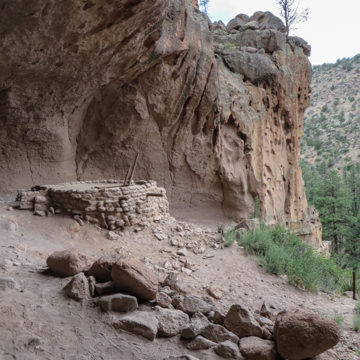You are here
Alcove House
Writing in 1909 about the excavations he was directing at Frijoles Canyon for an article in American Anthropologist, Edgar Lee Hewett called the Ceremonial Cave “the most picturesque object to be studied thus far in the Rito de Frijoles.” It is probably the most famous site at Bandelier, having been publicized in postcards, calendars, books, and other literature promoting tourism in New Mexico and evoking the romance of the ancient Southwest. Many of those images stage a Native American who looks out over Frijoles Canyon as he climbs out of the kiva in the Ceremonial Cave.
The Ceremonial Cave, now commonly referred to as Alcove House, is roughly 80 feet wide and located 150 feet about the canyon floor. The cave originally contained a talus structure with three cavates and approximately 20 rooms built with stone masonry. At the front of the cave is a small subterranean kiva, measuring between 12 and 13 feet in diameter. In 1910, Jesse Nussbaum, a student in Edgar Hewett’s field school at Bandelier, restored the kiva and built a series of stairways and ladders providing access to the cave.
This National Park Services site is open to the public during regularly scheduled hours, with shuttle transportation from the White Rock Visitor Center required for park entry between late May and mid October.
References
Hendron, Jerome W. Prehistory of El Rito de Frijoles: Bandelier National Monument. Coolidge, AZ: Southwestern Monuments Association, 1940.
Historic American Building Survey. “The Ceremonial Cave, Bandelier National Monument, Sandoval County, New Mexico (Photographs, Historical and Descriptive Data).” Historic American Buildings Survey Report (HABS Survey No. NM-17). Washington, D.C.: U.S. Department of the Interior, National Park Service, 1939.
Writing Credits
If SAH Archipedia has been useful to you, please consider supporting it.
SAH Archipedia tells the story of the United States through its buildings, landscapes, and cities. This freely available resource empowers the public with authoritative knowledge that deepens their understanding and appreciation of the built environment. But the Society of Architectural Historians, which created SAH Archipedia with University of Virginia Press, needs your support to maintain the high-caliber research, writing, photography, cartography, editing, design, and programming that make SAH Archipedia a trusted online resource available to all who value the history of place, heritage tourism, and learning.

